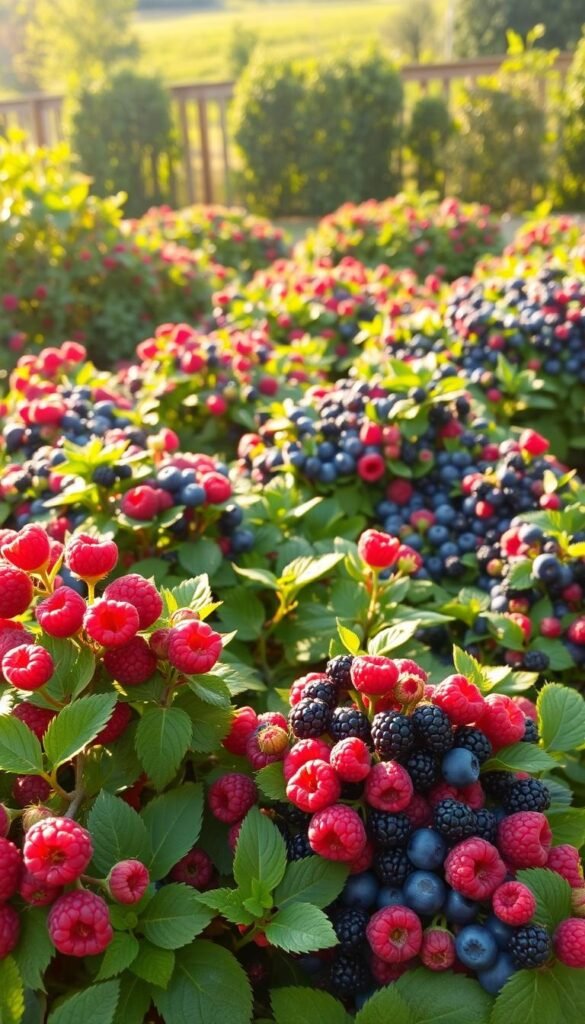Imagine stepping into your yard and plucking sweet, sun-ripened treats straight from thriving plants. Berry varieties offer an easy way to enjoy fresh flavors while enhancing your landscape’s beauty. Unlike traditional orchard trees, these compact growers thrive in backyard spaces of all sizes—even patio containers can yield surprising harvests.
What makes these plants special? The term “small fruits” refers to their juicy rewards, not their growth habits. Some varieties stretch taller than a basketball hoop, creating natural privacy screens. For example, certain blueberry cultivars reach 12-foot heights, while blackberry canes spread wider than a parking spot.
You’ll love how these multi-season performers keep your outdoor area productive. Early summer strawberries give way to mid-season raspberries, followed by fall-bearing types that sweeten crisp autumn days. This extended harvest means fresh snacks for months, not weeks.
Best of all, you don’t need farming experience to succeed. Many modern varieties resist pests and adapt to different climates. Whether you’re dressing up flower beds or filling empty corners, these plants work double duty—providing visual interest and pantry staples. That’s smart gardening at its tastiest!
Ready to explore more? Our growing guides break down everything from soil prep to pruning tricks. Let’s turn your green dreams into juicy reality!
Understanding the Basics of Berry Bush Gardening
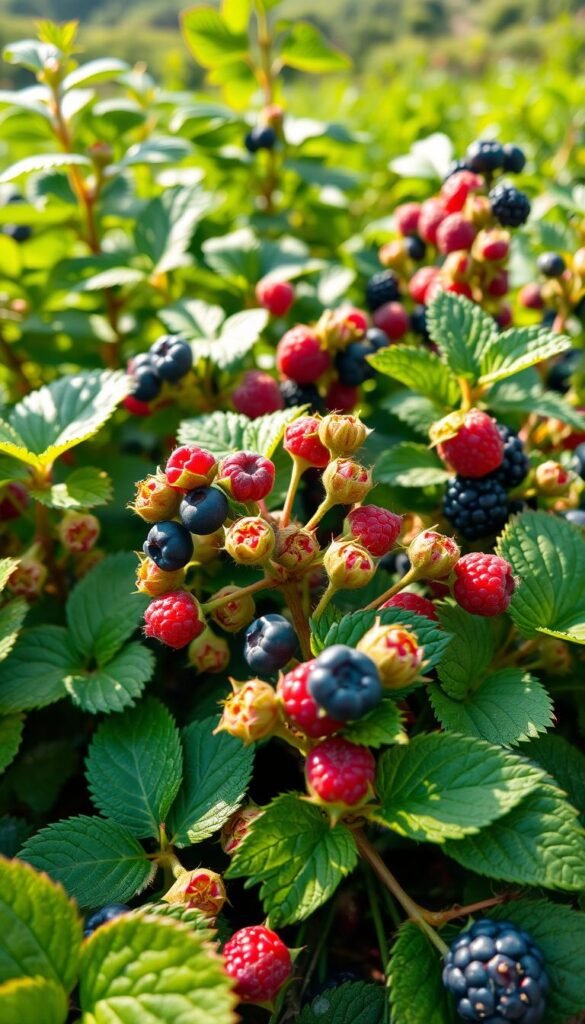
Growing your own berries unlocks a secret world of plant science and sweet rewards. Unlike typical vegetables or flowers, these growers follow their own rules – a mix of patience and payoff that keeps gardeners hooked.
The Crown-and-Cane Miracle
Here’s where things get interesting. Many berry plants use a dual life cycle. Their underground crown lives for decades, while above-ground canes work on a two-year schedule. First-year canes grow tall. Second-year ones burst with juicy fruits before retiring.
This system means you’ll always have new growth. While older canes fade, fresh ones take their place. Proper pruning helps maintain this rhythm. You’re not just growing berries – you’re managing a living production line.
Why Your Backyard Beats the Store
Homegrown varieties outshine supermarket options in three key ways:
| Factor | Store-Bought | Home Garden |
|---|---|---|
| Flavor Peak | Picked early | Harvested ripe |
| Nutrition | Declines in transit | Maximum vitamins |
| Cost | $5+/pint | Pennies after setup |
You control what goes into your plants. No mystery sprays. No wax coatings. Just sun-kissed fruits ready for pancakes or freezing. Better yet, one healthy plant can feed your family for years.
Space isn’t a deal-breaker either. Many berry types thrive in containers if ground space is tight. With the right conditions, you’ll turn any sunny spot into a productive patch.
Fruit Bushes Garden Ideas: Adding Raspberries, Blueberries, and Blackberries
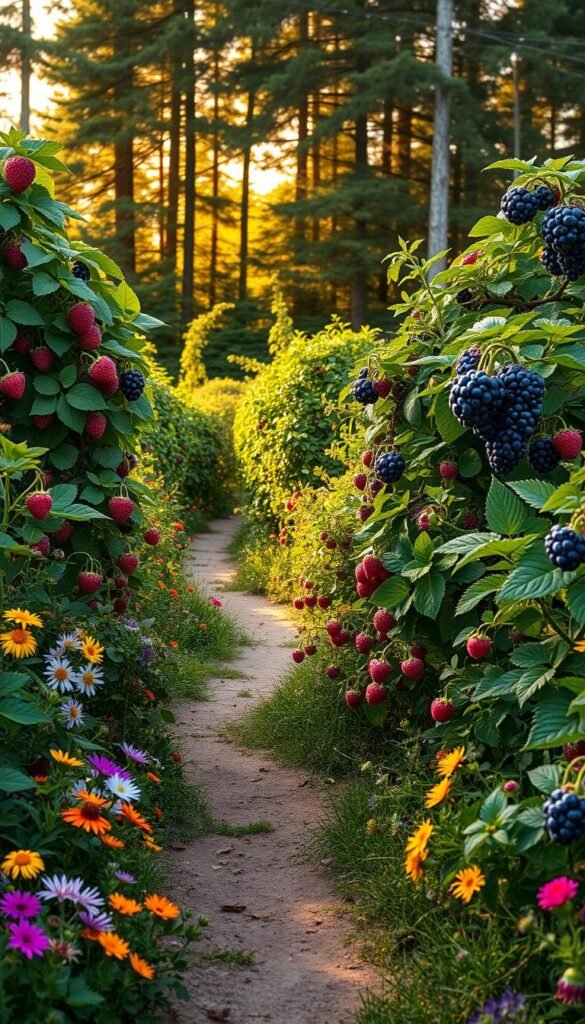
Transform your outdoor area into a productive paradise with clever berry bush arrangements. Tall varieties create living walls, while compact plants thrive in pots. Let’s explore layouts that turn every corner into a snack station.
Traditional caneberries like heritage raspberries stretch skyward, perfect for framing patios or hiding fences. Pair these giants with dwarf varieties such as Raspberry Shortcake (3 feet tall) for layered interest. Their thornless canes simplify harvesting without sacrificing flavor.
| Plant Type | Height | Best Use | Key Features |
|---|---|---|---|
| Traditional Canes | 7-8 ft | Natural screens | High yields, vigorous growth |
| Compact Varieties | 3-4 ft | Containers | Thornless, full-size fruit |
Create edible boundaries using blackberry hedgerows along property lines. Space plants 4 feet apart for airflow. In tight quarters, try stacking pots with different berry types – blueberries up top, trailing blackberries below.
Vertical trellises maximize space while showcasing flowering canes. Train raspberries on arched supports for a striking tunnel effect. For continuous harvests, mix early and late-season varieties in the same bed.
Balcony gardeners rejoice! Baby Cakes blackberries produce pints of fruit in 24-inch pots. Their compact size fits fire escapes while resisting common diseases. Just ensure six hours of sun and watch your snack garden flourish.
Choosing the Right Berry Varieties and Plants
Your berry-growing success starts long before planting – it begins at the nursery. Smart selection means balancing flavor preferences with practical needs. Let’s break down what really matters when picking your plants.
Health First: Start Strong
Always choose certified disease-free stock. Viruses like raspberry bushy dwarf can linger in soil for decades. Reputable growers provide documentation showing their plants underwent rigorous testing. Look for nurseries offering 1-year guarantees – it shows confidence in their stock.
| Variety | Region | Cold Tolerance | Special Features |
|---|---|---|---|
| Heritage | Zones 4-8 | -25°F | Fall-bearing, self-pollinating |
| Dormanred | Zones 7-9 | 15°F | Heat-tolerant, everbearing |
| Prime Ark Freedom | Zones 6-10 | -10°F | Thornless blackberry |
Climate Matchmakers
Your zip code dictates your plant options. Mountain gardeners need cold-hardy types that protect buds during frosty winters. Southern growers should prioritize heat resistance. Check USDA zone maps and local extension office recommendations.
Pro tip: Hybrids often outperform heirlooms in challenging conditions. For humid areas, try disease-resistant varieties like Ouachita blackberry. In drought zones, consider low-water options such as Apache thornless.
Remember – labels tell half the story. Dig deeper into pollination needs. While many blueberries require cross-pollination partners, newer plants like Top Hat work solo in containers. Pair this knowledge with your space and goals for a harvest that’s truly yours.
Preparing Your Garden: Soil, Sun, and Raised Beds
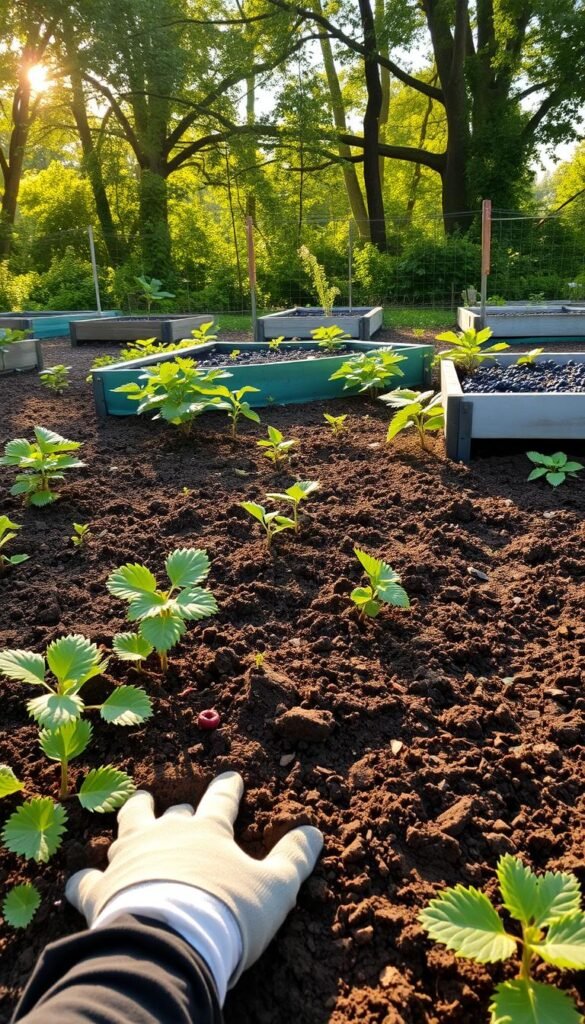
Great berry harvests begin with smart groundwork. Start by scouting locations that soak up 6-8 hours of daily sunlight. South-facing slopes or open areas work best, avoiding shadows from buildings or trees.
Testing and Amending Soil pH
Grab a soil test kit from your local nursery. Blueberries demand acidic conditions (pH 4.5-5.5), while other varieties tolerate slightly higher levels. If your ground doesn’t match these needs, don’t panic!
| Plant Type | Ideal pH | Amendments |
|---|---|---|
| Blueberries | 4.5-5.5 | Pine needles, coffee grounds |
| Caneberries | 5.6-6.2 | Compost, peat moss |
For alkaline soils, raised beds become your secret weapon. They let you create custom growing zones. Mix 40% peat moss with 60% native soil for blueberry beds. Always retest after amendments.
Designing Raised Beds for Airflow
Build frames 3-4 feet wide – narrow enough to reach the center. Depth matters: 18 inches accommodates most roots. Leave 5-foot pathways between beds for easy access and air movement.
| Bed Height | Material | Spacing |
|---|---|---|
| 12-18″ | Cedar/Redwood | 4-5′ apart |
| 24″ | Galvanized Steel | 6′ apart |
Elevated beds prevent waterlogging and let cold air drain away. Fill them with a mix of topsoil, compost, and perlite. This setup reduces fungal issues while keeping roots happy and productive.
Planting Techniques and Seasonal Strategies
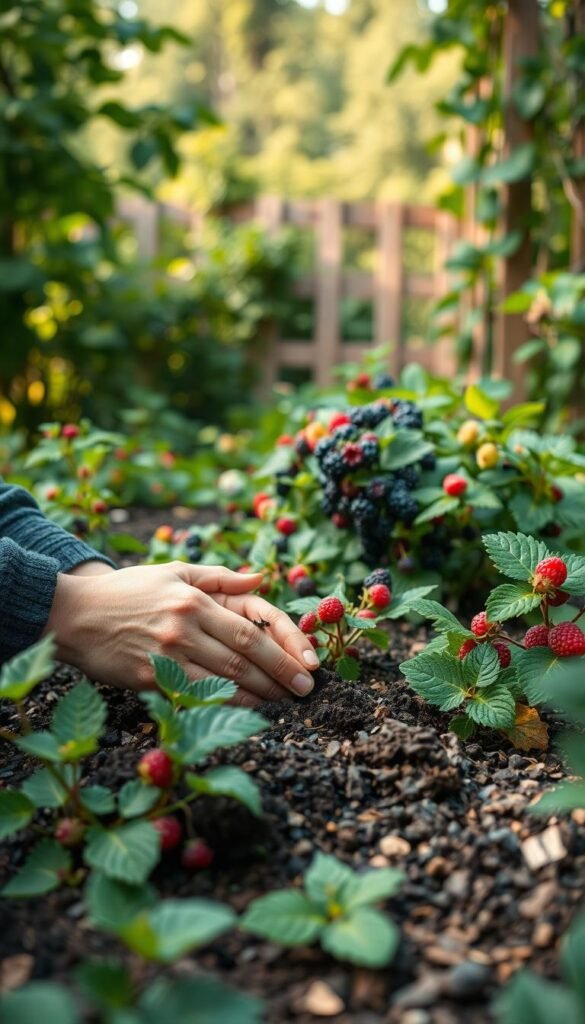
Timing transforms hopeful planting into fruitful success. Early spring reigns supreme across North America for establishing plants, as thawed soil and rising temperatures wake dormant roots. But don’t rush – wait until frost risks vanish to avoid chilled shocks.
Calendar Wisdom for Rooted Success
March through May offers prime conditions for bare-root stock. These sleeping plants need cool earth to settle before summer heat. Container-grown options stretch your window – plant them anytime ground isn’t frozen.
Southern gardeners gain fall opportunities. October plantings let roots develop without top growth competing. Just ensure 6 weeks before first freeze for establishment.
Roots Meet Earth: A Careful Dance
Bare-root plants demand hydration first. Soak roots 2-4 hours in water mixed with seaweed extract. Trim broken roots with sterilized shears before nestling into prepared holes.
| Plant Type | Hole Width | Depth Adjustment |
|---|---|---|
| Bare-Root | 12-18″ | Crown at soil line |
| Container | 2x pot size | Match original level |
Space cane plants 2-3 feet apart – enough elbow room for air flow. Trailing types stretch wider, needing 10 feet between neighbors. For backyard spaces, arrange rows north-south for even sun exposure.
Post-planting care seals success. Water deeply, then mulch with straw to conserve moisture. Shield new plants with burlap if late frosts threaten. Your patience now pays in seasons ahead!
Caring for Your Berries: Watering, Mulching, and Fertilizing
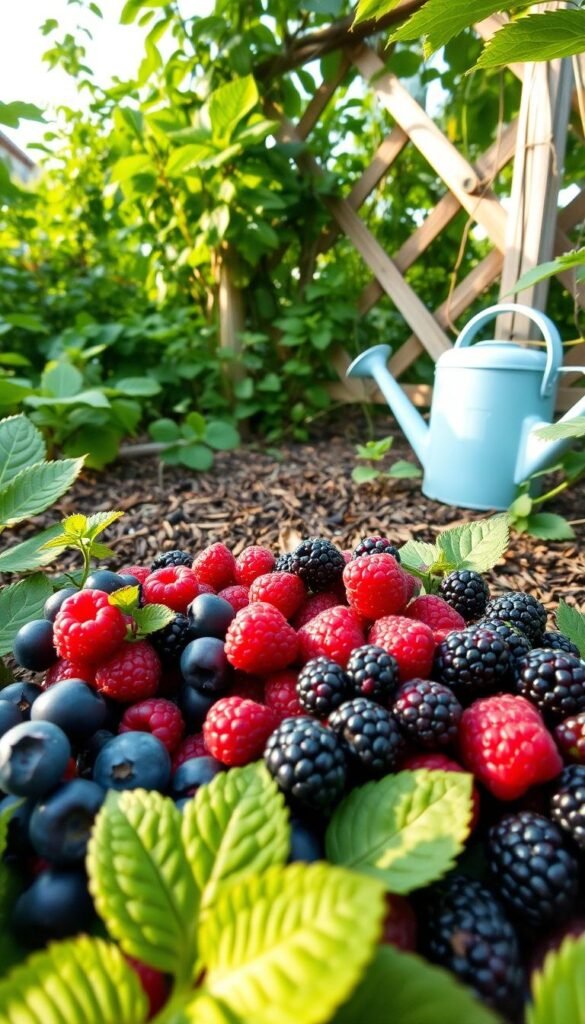
Healthy plants reward you with juicy harvests when given consistent care. Three elements work together to create thriving canes: precise hydration, protective ground cover, and timely nutrition. Let’s explore how these practices keep your patch productive through every season.
Optimal Watering Practices Throughout the Year
Plants need 1-2 inches of water weekly during growth spurts. Use a rain gauge to track natural rainfall. When dry spells hit, soak roots deeply instead of frequent light sprinkles – this encourages drought resilience.
Check soil moisture by sticking your finger 2 inches deep. If it feels dry, set up drip lines or soaker hoses. Morning watering reduces evaporation and prevents fungal issues. Adjust schedules every 2-3 weeks as temperatures shift.
Using Organic Mulch and Compost for Nutrient Boost
Spread 3-4 inches of mulch around plants each spring. Pine needles or shredded bark suppress weeds while locking in moisture. As materials break down, they feed earthworms and improve soil structure.
| Material | Benefits | Refresh Timing |
|---|---|---|
| Straw | Insulates roots | Every 6 months |
| Leaf Mold | Adds nitrogen | Annually |
Mix compost into topsoil before applying fertilizer. A balanced 10-10-10 formula in early spring fuels new growth. Follow up 12-16 weeks later with a potassium-rich blend to support fruit development. Always water after feeding to activate nutrients.
Pruning and Supporting Your Berry Bushes
Sharp shears and smart support turn tangled canes into productive powerhouses. Proper pruning boosts yields while preventing disease spread. Annual maintenance keeps plants vigorous by removing old growth that drains energy from fruit production.
For summer-bearing varieties, cut spent floricanes at ground level after harvest. Fall-bearing types benefit from late winter trimming – remove just the tips that fruited last season. Always disinfect tools between plants to avoid transmitting infections.
Support systems prevent breakage and improve air circulation. Install T-shaped trellises for trailing varieties, training canes along horizontal wires. Upright growers thrive with simple stake-and-twine setups. Your plants will reward you with larger berries and easier picking!
Container-grown specimens need extra attention. Use bamboo poles or compact cages to manage growth in limited spaces. Check ties monthly – adjust as stems thicken to avoid girdling. With consistent care, your edible landscape becomes both functional and beautiful.

